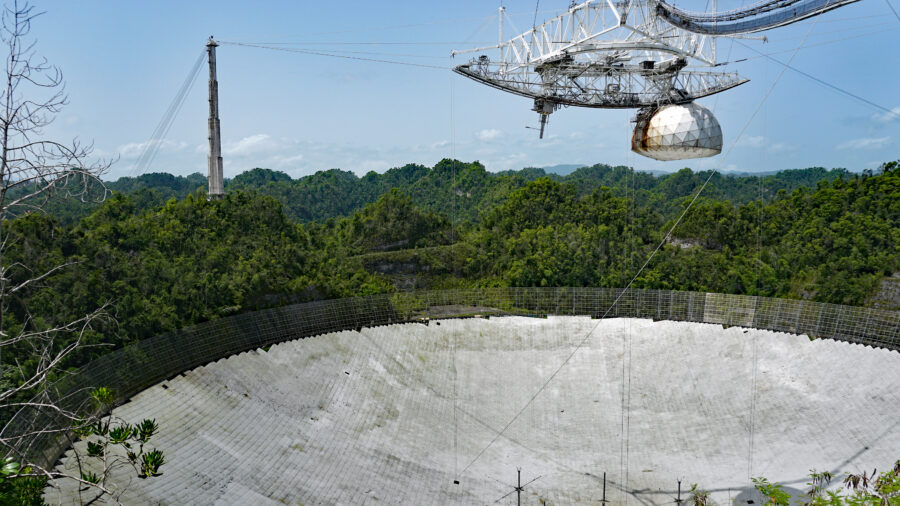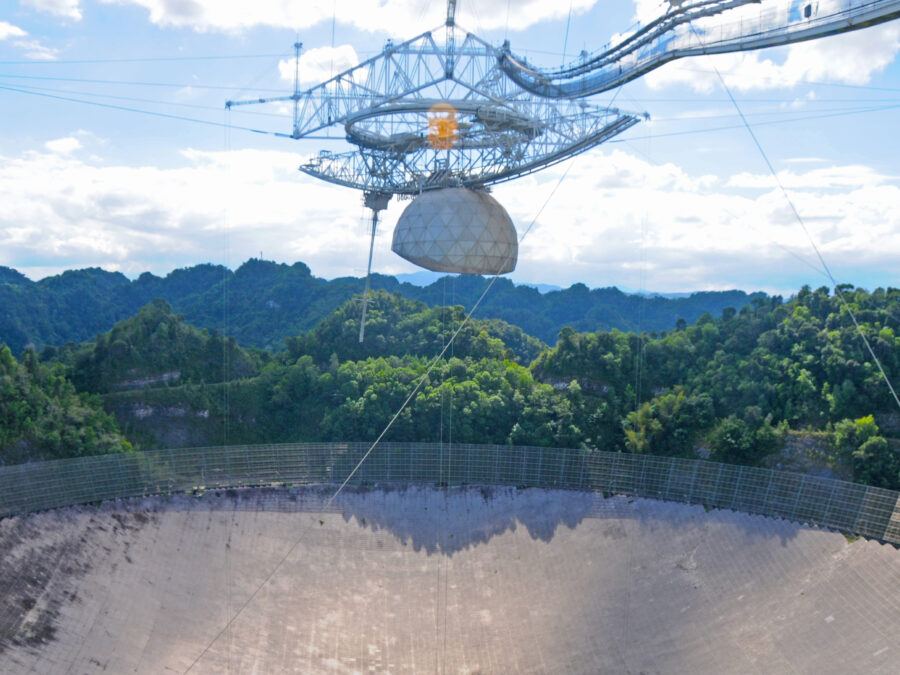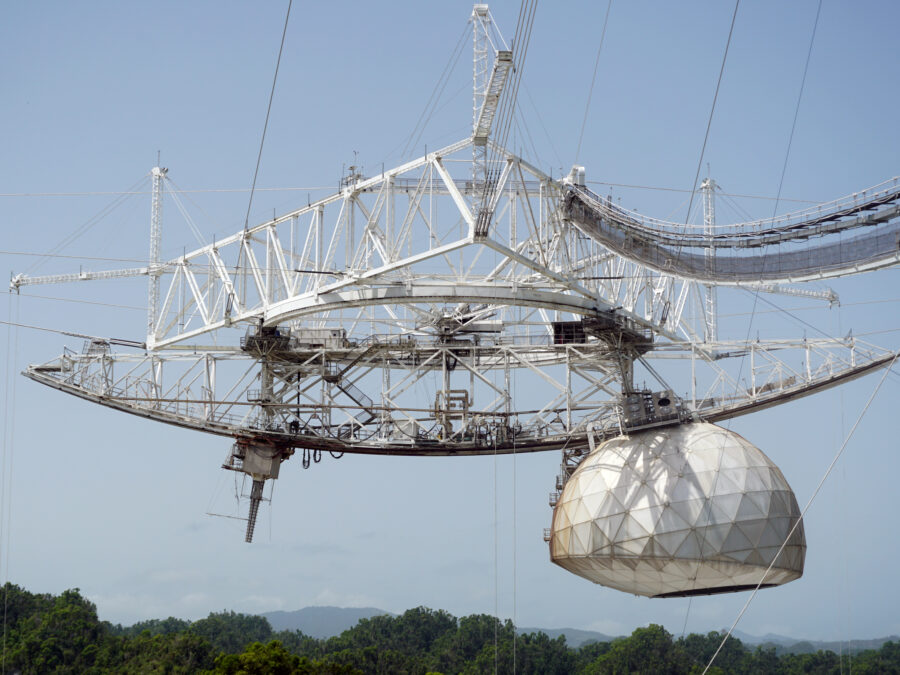The Iconic Arecibo Telescope Seen In GoldenEye Has Collapsed
The iconic GoldenEye locale has collapsed.
This article is more than 2 years old

News out of Puerto Rico has gone from bad to worse as the world-famous Arecibo Observatory, best known for its appearance in the James Bond film GoldenEye, has finally collapsed.
We say finally because the National Science Foundation’s facility has been closed since August when an auxiliary cable, which had been installed in the 1990s at some point before or after GoldenEye filmed there, pulled free from its socket on one of the support towers causing a 100-foot tear on the reflector dish. Engineers were developing a plan to repair the telescope when things took a bad turn. In early November, one of the 3-inch cables that were attached to the same tower unexpectedly broke. This caused additional stress on the remaining cables because of the tilt from the instrument platform.
Because of these two incidents, the University of Central Florida, who took over management and operations in 2018 when the National Science Foundation cut its annual contribution from $8 million to $2 million, brought out engineers to assess the early damage. Their conclusion was a controlled demolition of the iconic GoldenEye locale. “After reviewing the engineering assessment, we have found no path forward that would allow us to do so safely,” said Sean Jones, the assistant director for the Mathematical and Physical Sciences Directorate at the National Science Foundation, back in November.

He added via CBS News, “We know that a delay in decision making leaves the entire facility at risk of an uncontrolled collapse, unnecessarily jeopardizing people and also the additional facilities.” He was correct in that assessment as the planned demolition never made it past the early planning stages. The 900-ton platform, which was suspended over the radio dish, took care of that when it fell 450 feet, crashing below and causing massive damage.
“We heard a loud sound, a loud bang outside the control room. We started to see the eventual downfall of the observatory,” said Ángel Vázquez on a Twitter video. Vasquez is the chief of telescope operations and has been working at Arecibo for four decades.
Ángel Vázquez and other workers at Arecibo knew it was coming. He said that throughout the past week they saw strands of cable coming apart on the three remaining cables that were holding up one side of the platform. The stress on the GoldenEye location was simply too much. “Eventually, it just gave way,” he said via Space.
The Arecibo Observatory is famous for many reasons, one being that it was the backdrop of a couple of feature films to include GoldenEye, the James Bond movie starring Pierce Brosnan, and Contact, the movie based on the novel by Carl Sagan and starring Jodie Foster. But these weren’t the only reasons the observatory was famous. Not by a long shot.
The Arecibo Observatory was built over five decades ago when scientists decided they needed a radio telescope that was close to the equator. The location of this would allow scientists to track planets overhead, also allowing them to explore the ionosphere – this the where the charged particles produce our northern lights. The area in Puerto Rico was perfect for the telescope as it was set in limestone sinkholes that “provided a natural geometry.” When it was built, it was the world’s largest radio telescope until 2016, when China completed its Five-hundred-meter Aperture Spherical Telescope’s (FAST) giant dish.

One of Arecibo’s main duties was to search and find extra terrestrial intelligence. The program was initiated in 1974 and was called SETI (Search for Extra Terrestrial Intelligence). It was then that Arecibo broadcast a pictorial message into space which was aimed at M13, a global cluster of stars that scientists hoped held promise for life. They knew it would take some time to get the message to the cluster as it was nearly 21,000 light-years away. Back in 1999, past Arecibo’s director, Harold Craft noted, “We translated the radio-frequency message into a warbling audio tone that was broadcast over speakers at the ceremony. When [the tone] started, much of the audience spontaneously got up and walked out of the tent and gazed up at the telescope.” According to SETI, the broadcast was sent out on what equates to a 20-trillion-watt omnidirectional broadcast. Simply speaking, the broadcast would be picked up by any receiver in the galaxy that is around the same size as Arecibo’s.
While the collapse of the observatory comes as quite a shock, it is amazing that it has stood for as long as it had. Back in 2017, Category 4 Hurricane Maria destroyed the island of Puerto Rico, killing hundreds and causing widespread power outages. The structure of the Arecibo received some damage as the 96-foot line feed antenna suspended above the radio dish broke and punctured the dish below. The observatory received a $16.3 federal relief fund which helped with repairs.
The news hit the scientific world with shock and sadness as they understood the massive loss to their community. A Puerto Rican meteorologist, Deborah Martorell, tweeted out the news of the collapse, “Friends, it is with deep regret to inform you that the Arecibo Observatory platform has just collapsed.”
The University of Central Florida’s Elizabeth Klonoff, vice president of research, said, “We knew this was a possibility, but it is still heartbreaking to see. Safety of personnel is our number one priority. We already have engineers on site to help assess the damage and determine the stability and safety of the remaining structure. We will continue to work with the NSF and other stakeholders to find ways to support the science mission at Arecibo.” The director of the National Science Foundation, Sethuraman Panchanathan, added, “We are saddened by this situation but thankful that no one was hurt as a result. When engineers advised NSF that this structure was unstable and presented a danger to work teams and Arecibo staff, NSF took their warnings seriously and worked to make sure that we were prepared for this outcome. Our focus is now on assessing the damage, finding ways to restore other parts of the observatory to operations and working to continue supporting the scientific community and people of Puerto Rico.”
The question now being asked is what of the buildings surrounding the telescope. Initial plans as they were forming to demolish the telescope included keeping the laser and visitor centers intact. This plan seems to be in the air right now.
You can see the destruction done by the collapse of the iconic GoldenEye location in drone footage below.











